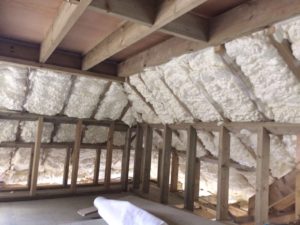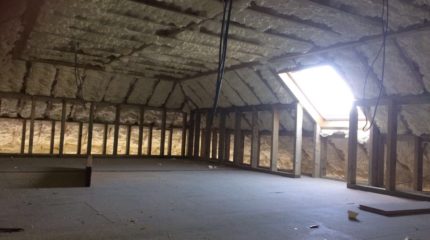Room in Roof Insulation Guide
About IcyneneWhether you envision your loft space as a kid’s hangout, a serene home office, or a master suite, it must be insulated before turning it into a habitable living space. Why so? According to industry estimates, attic rooms account for 25% of all heat loss from an uninsulated home. Insulating this space is one of the most cost-effective and energy-saving solutions to cut down on energy bills.
Most old homes were built with little-to-no loft insulation—leaving a plaster ceiling, the roof, and lath as the only barrier between residents and the outside world. Even now, it’s relatively common to find loft spaces with poorly performing or insufficient insulation. In such cases, it’s important to install loft insulation to insulate the roof.
Read on for a no-fluff guide that includes everything you need to know about the benefits and cost of the room in roof insulation.
What is Room in Roof Insulation?
First things first; what is room in roof insulation? It’s the process of installing insulation in a roof space that has been spruced up into a room—replacing the existing standard loft insulation.
Converted attic rooms demand a different type of insulation that fits into the gaps between the cavity wall and the joists. The insulation material (e.g., spray foam) is installed underneath the walls and between the roof’s rafters.

How Does Room in Roof Insulation work?
In an uninsulated home, heat rises and escapes through the loft space. This leaves the house susceptible to drastic temperature changes in both winter and summer. Aside from making your living space uncomfortable, the unchecked heat loss takes a toll on your energy bills.
Room in roof insulation facilitates energy saving by creating a blanket effect to trap heat in your house while protecting the living space against the cold outside. This allows you to maintain a steady temperature during winter without racking up huge heating bills.
For more information on how what Icynene spray foam insulation is, you can read our guide here.
What are the Benefits of Loft Insulation?
- Improves the Cosiness Factor of your Living Space: Insulating the loft makes the space warmer during the cold winter nights and cooler in hot summer days. This inherently makes it a more habitable and cosy living space.
- Cost-Saving: Installing insulation boarding allows you to significantly cut down your energy bills through energy efficiency. The initial cost of insulation for the room in your roof from a professional installer may seem high—but it pays for itself many times over throughout its 40-year shelf life.
- It’s Good for the Environment: A well-insulated home leads to a more efficient heating system and lower emissions—hence reducing your Carbon footprint.
- Home Value: A cosy home with a spruced-up loft space, a low Carbon footprint, and energy-saving measures is inherently more desirable.
How Much Does Room in Roof Insulation Cost?
Any home improvement effort is poised to set you back a couple of pounds. It’s all about weighing the costs and returns of the investment. The cost of loft insulation depends on several variables including the size of the area, thickness, and type of insulation material. Moreover, the cost is likely to increase if you have damp problems or a flat roof.
Spray foam insulation often costs more than standard loft insulation—but it leads to long-term cost savings due to its superior qualities. Unlike cheap fibreglass insulation, super spray foam has great soundproofing abilities, it’s non-toxic, significantly reduces heat loss, seals out air leaks, and it does not decay.
It’s advisable to schedule a pre-installation survey with a professional installer to inspect the area that needs insulation before providing a quote.
Are There Any Restrictions?
For safety reasons, there are regulations and restrictions in place regarding what qualifies for room in roof insulation. The main restrictions that you should keep tabs on include:
- The roof space should not be weakened or damaged in any manner. This includes faulty electrical connections, flaking or rotting timber, mould, and damp problems.
- The rafters and other elements of the loft space need to be properly ventilated.
- At least half of the vertical walls should not be higher than 1.8 metres.
- You must install a standard staircase for easy access – i.e., no attic ladders.
- You must not have a loft conversion which will restrict access for the spray foam.
Can I Install it Myself?
A DIY installation of room in roof insulation is possible – but it’s not advisable. You need to ensure everything is in line with Building Regulations; including taking fire resistance into consideration, handling electrical cables, and dealing with specific ventilation restrictions. You also have to ensure you maximize the efficiency of the insulation for the best results. Rather than winging it, it’s better to use a professional installer. When it comes to cavity wall insulation, again you need to ensure everything is in line and that all risks are considered – it is highly not recommended to apply this insulation yourself.
The spray foam installation process requires a lot of professional equipment to ensure the job is done correctly. With an incorrect application, the energy efficiency gains of the spray foam insulation will not be up to par and can cost you a lot of money in the long run through heating bills. Ultimately, if your aim is to reduce the cost of heating bills, applying spray foam insulation yourself is not the way to go.
Mass Foam Systems is a team of certified, well-equipped, and experienced individuals who guarantee clean, safe, and high-quality room in rood insulation services all over England. Contact us today at 0800 246 5051 for more information.
Back to blogs



